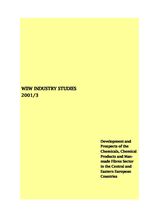Development and Prospects of the Chemicals, Chemical Products and Man-made Fibres Sector in the Central and Eastern European Countries
wiiw Industry Study No. 2001/3, November 2001 plus free access to wiiw Industrial Database
Access to wiiw Industrial Database
In Central and Eastern Europe, as in most other economies, the chemical sector is a key part of manufacturing, characterized by high concentration and fierce competition. It is considered a capital-, R&D- and skill-intensive industry, producing a wide range of products (e.g. soaps, cosmetics, pharmaceuticals, fertilizers, plastics and synthetic rubber etc.). In Central Europe, the sector has turned from a priority sector during communism into a problematic, declining sector during transition, troubled by the loss of former CMEA markets and strong import competition.
The study investigates the development and prospects of the chemical sector in the following countries: Bulgaria, the Czech Republic, Hungary, Poland, Romania, Slovakia, Slovenia.
In size, the chemical sector is still of relatively great importance in the Central and Eastern European countries, contributing between 6% and 8% of manufacturing output; it holds an even more prominent position in Slovenia and Bulgaria (10%). The production structure is dominated by 'basic chemicals'. 'Pharmaceuticals' play an important role in some countries.
In terms of chemical exports, trade orientation towards EU markets is below-average - the EU(15) only account for 30% to 50% of total CEE chemical exports today. Hence, in CEE manufacturing exports to the EU, the chemical sector is of minor importance, with shares ranging between 3% in Romania and 7% in Bulgaria. Export growth was negative or weak in most CEECs, only Slovenia's exports to the EU grew quite dynamically. Main export products are 'basic chemicals'.
In terms of chemical imports, chemical products from the EU(15) do play a major role and account for 60% to 70% of all CEE chemical imports today. Thus, in CEE manufacturing imports from the EU, import shares account for 9% to 13%. Foreign companies offer a wider range of products than domestic ones, use better marketing and have well-known brand names. The import structure is quite diversified; main import products include 'basic chemicals', 'pharmaceuticals' and 'other chemical products'. The chemical sector was a net importer from the EU in all CEECs in 1995 to 1999. Compared to total manufacturing, the sector shows a revealed comparative disadvantage, which is even deteriorating, and a relatively large negative and persistent price/quality gap indicator.
On the EU market, the position of CEE chemical exports is weak and deteriorating: in 1995, CEEC(7) chemical exports had a market share of 7%, which decreased to 5% in 1998 (all shares without intra-EU trade). This share was significantly below total manufacturing market shares (9% in 1989 and 11% in 1999). On the Austrian market, CEE exports had a decisively larger share, accounting for 22% of Austria's non-EU imports of chemical products in 1995 and falling to 20% in 1999. The CEECs' position as a major export destination for Austrian chemical exports is also diminishing (29% of Austria's non?EU exports in 1999). In total, the CEECs registered a sectoral trade deficit with Austria.
The future prospects of the sector are quite mixed: While export competitiveness on EU markets decreased, better growth potentials exist on the domestic and CEE markets, which are however increasingly challenged by strong import competition from EU companies. For the future, ongoing restructuring, modernization and ecological upgrading have to be pursued in order to meet international demand and to comply with EU regulations.
Keywords: chemicals, chemical products and man-made fibres sector, pharmaceutical industry, manufacturing, transition countries
JEL classification: L6, L65
